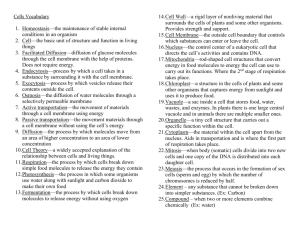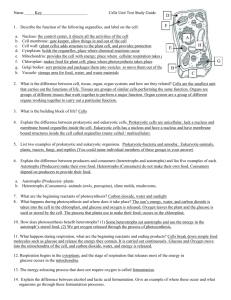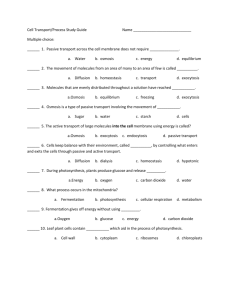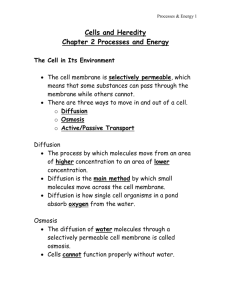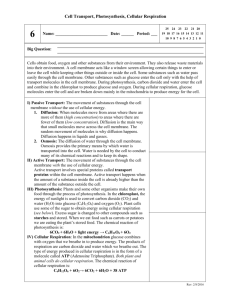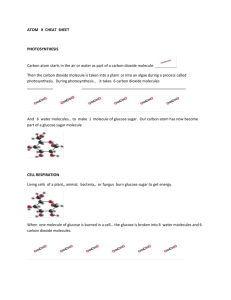Cell Processes - Spokane Public Schools
advertisement
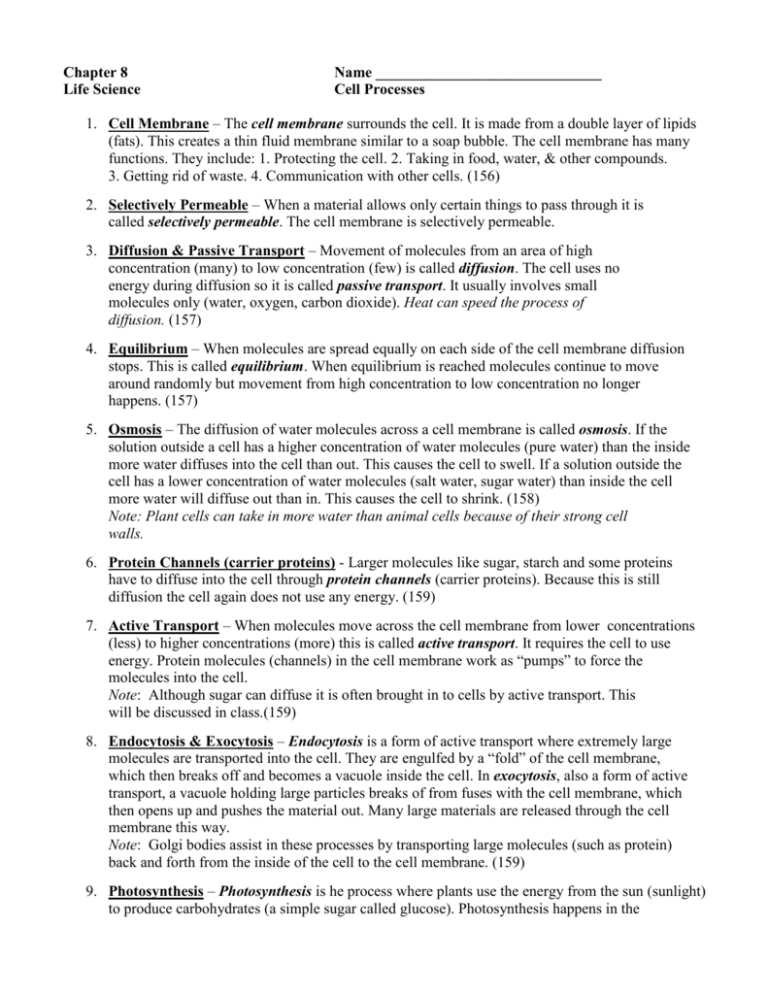
Chapter 8 Life Science Name ______________________________ Cell Processes 1. Cell Membrane – The cell membrane surrounds the cell. It is made from a double layer of lipids (fats). This creates a thin fluid membrane similar to a soap bubble. The cell membrane has many functions. They include: 1. Protecting the cell. 2. Taking in food, water, & other compounds. 3. Getting rid of waste. 4. Communication with other cells. (156) 2. Selectively Permeable – When a material allows only certain things to pass through it is called selectively permeable. The cell membrane is selectively permeable. 3. Diffusion & Passive Transport – Movement of molecules from an area of high concentration (many) to low concentration (few) is called diffusion. The cell uses no energy during diffusion so it is called passive transport. It usually involves small molecules only (water, oxygen, carbon dioxide). Heat can speed the process of diffusion. (157) 4. Equilibrium – When molecules are spread equally on each side of the cell membrane diffusion stops. This is called equilibrium. When equilibrium is reached molecules continue to move around randomly but movement from high concentration to low concentration no longer happens. (157) 5. Osmosis – The diffusion of water molecules across a cell membrane is called osmosis. If the solution outside a cell has a higher concentration of water molecules (pure water) than the inside more water diffuses into the cell than out. This causes the cell to swell. If a solution outside the cell has a lower concentration of water molecules (salt water, sugar water) than inside the cell more water will diffuse out than in. This causes the cell to shrink. (158) Note: Plant cells can take in more water than animal cells because of their strong cell walls. 6. Protein Channels (carrier proteins) - Larger molecules like sugar, starch and some proteins have to diffuse into the cell through protein channels (carrier proteins). Because this is still diffusion the cell again does not use any energy. (159) 7. Active Transport – When molecules move across the cell membrane from lower concentrations (less) to higher concentrations (more) this is called active transport. It requires the cell to use energy. Protein molecules (channels) in the cell membrane work as “pumps” to force the molecules into the cell. Note: Although sugar can diffuse it is often brought in to cells by active transport. This will be discussed in class.(159) 8. Endocytosis & Exocytosis – Endocytosis is a form of active transport where extremely large molecules are transported into the cell. They are engulfed by a “fold” of the cell membrane, which then breaks off and becomes a vacuole inside the cell. In exocytosis, also a form of active transport, a vacuole holding large particles breaks of from fuses with the cell membrane, which then opens up and pushes the material out. Many large materials are released through the cell membrane this way. Note: Golgi bodies assist in these processes by transporting large molecules (such as protein) back and forth from the inside of the cell to the cell membrane. (159) 9. Photosynthesis – Photosynthesis is he process where plants use the energy from the sun (sunlight) to produce carbohydrates (a simple sugar called glucose). Photosynthesis happens in the chloroplasts of the cell. Carbon dioxide and water are the reactants used in the reaction. These reactants are changed into the products of glucose (sugar) and oxygen. Plants can then use the glucose (sugar) for energy when they need it. (162) Note: The carbon dioxide used in photosynthesis enters the leaf on the bottom side through openings called stomates. Oxygen, left over after the process, is released out the same openings into the air. Humans & all other animals can then use the oxygen for life processes. 10. Producers & Consumers – Because plants produce their own food (glucose) during photosynthesis they are called producers. Remember that plants are also the beginning of every food chain. Consumers are animals that have to eat other organisms (plants or animals) to get their energy. They cannot produce their own food like a plant does. 11. Pigment – A molecule that absorbs some colors of light but reflects others is called a pigment. (164) 12. Chlorophyll – The main pigment used in photosynthesis is the green pigment called chlorophyll. It is the chlorophyll that allows plants to make their own food. It is found in the chloroplasts of the cell. Chlorophyll absorbs/traps mostly blue and red light, and reflects green. This is why most plants are green. Plants need red and blue light to grow. When the days get shorter in the fall photosynthesis slows down and chlorophyll begins to break down. It will no longer mask (hide) the other pigments in the leaves so the trees change color and the leaves fall. (164) 13. Cellular Respiration & ATP – The energy releasing process in both plants and animals is called respiration. Cellular respiration is the process in which the chemical bonds in energy-rich food molecules are broken apart and then converted into energy. In eukaryotic cells this takes place in the mitochondria. In the process the reactants glucose (sugar) and oxygen are converted into the products of carbon dioxide, water, and energy. Part of the energy released is in the form of a molecule that stores and transfers the energy within the cell. It is called ATP. Energy is also released and lost in the form of heat. Your body is warm because of that heat. (165) 14. Respiration – The act of breathing is called respiration. When you inhale you bring in the oxygen needed for cellular respiration. When you exhale you get rid of carbon dioxide and water vapor produced as wastes during cellular respiration. (165) 15. Fermentation – A form of respiration that converts energy from glucose when oxygen is in low supply is called fermentation. This process only produces small amounts of energy and leaves behind a substance called lactic acid. Lactic acid is what makes your over-worked muscles sore after a hard workout. Fermentation is also used to make some foods and beverages because of the alcohol and carbon dioxide which are given off as wastes during the process. Yeast cells are used in this process (bread, wine, & beer). 16. Metabolism – All the chemical activities & changes within the cell of an organism that allow it to stay alive, grow, & reproduce is called the cell metabolism. Cellular respiration, fermentation. and photosynthesis are part of a cell’s metabolism. 17. Comparing Plants and Animals – Plants use carbon dioxide and water during photosynthesis, and produce glucose and oxygen. Animals use glucose and oxygen during cellular respiration and produce carbon dioxide and water as wastes. This shows that we depend on each other for the materials we need for our life processes. Remember: Plants use small amounts of oxygen and glucose during cellular respiration just like we do. (167)


